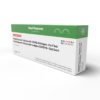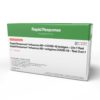Whether you’re trying to conceive or avoiding pregnancy, knowing about ovulation can help you understand your body better.
Here’s a quick look at what you need to know about ovulation:
- What it is
- How to recognize its signs
- Why tracking helps
- Common misconceptions about ovulation
- How to track your ovulation
What is ovulation?
When you ovulate, an egg is released from one of your ovaries, which makes it available for fertilization. This process is key for reproduction.
The release of the egg is controlled by hormones, especially the luteinizing hormone (LH). A surge in LH levels about 24-36 hours before ovulation signals the ovary to release the egg.
How do you know if you’re ovulating?
Here are the most common signs and symptoms of ovulation, although your experience may differ significantly from someone else’s.
Aside from that, there’s also a chance that you may experience some of the symptoms in one month but not the next. When you don’t, it doesn’t directly mean that you’re not ovulating.
1. Change in basal body temperature
A change in basal body temperature (BBT) is a common sign of ovulation. Basal body temperature refers to your body’s temperature when you’re fully at rest, and it’s usually measured first thing in the morning.
Around the time of ovulation, hormonal shifts cause a slight increase in BBT, typically by about 0.5°F to 1.0°F. This rise is triggered by the hormone progesterone, which is released after the ovary releases an egg.
Tracking your BBT over several months can help you identify patterns and predict when you are ovulating. Before ovulation, your temperature stays relatively consistent, and after ovulation, the slight increase in BBT lasts until your next menstrual period.
2. Changes in cervical mucus
As you approach ovulation, your body produces more estrogen, which causes your cervical mucus to change in both texture and amount. Just before and during ovulation, the mucus starts to resemble the consistency of raw egg whites. Particularly, you may notice it as:
- Clear
- Stretchy
- Slippery
This type of mucus creates a more sperm-friendly environment wherein it’s easier for sperm to travel through the cervix and reach the egg.
After ovulation, the cervical mucus may become:
- Thicker
- Cloudier
- Less noticeable
3. Mid-cycle pain or cramping (Mittelschmerz)
Pain on one side of the lower abdomen, known as Mittelschmerz, is a symptom some people experience during ovulation. This discomfort occurs where the ovary is releasing an egg. The pain can vary from a mild twinge to more intense cramping and may last anywhere from a few minutes to several hours.
Mittelschmerz is caused by the growth and release of the egg from the follicle in the ovary. Some people may also notice light spotting or an increase in cervical mucus at this time. While not everyone experiences ovulation pain, those who do may find it a helpful indicator of their fertility window.
4. Increased libido
Experiencing a heightened sex drive is a common sign of ovulation for many people. This spike in sexual desire is thought to be linked to the hormonal changes that occur around your ovulation, particularly the rise in estrogen and luteinizing hormone (LH).
These hormones help prepare your body for potential conception, and the increase in libido is a natural response that encourages sexual activity during the most fertile period of your menstrual cycle.
While this symptom often occurs just before or during ovulation, libido can be influenced by many factors, so not everyone experiences this increase in sexual desire around ovulation.
5. Breast tenderness
After ovulation, the hormone progesterone rises to prepare the body for a possible pregnancy. With this, your breasts may feel:
- Swollen
- Tender
- Sore
- Fuller
- More sensitive to touch
The level of discomfort can vary from person to person and can be mild or more noticeable. Breast tenderness may begin after ovulation and may continue until the start of your next menstrual cycle, when progesterone levels drop if pregnancy does not occur.
6. Heightened sense of smell
While it’s less common, having a heightened sense of smell is a notable symptom of ovulation. When you’re fertile, you tend to be more sensitive to certain scents. This is believed to be linked to the surge in hormones, particularly estrogen, which occurs around ovulation.
Your body may become more responsive to pheromones or smells associated with attraction during this time, which is possibly a way to increase the chances of conception.
While this symptom is not experienced by everyone, it can serve as a subtle cue that ovulation is approaching for those who notice it.
Why is tracking ovulation important?
Knowing when you are fertile is helpful, especially when you’re:
- Planning a pregnancy. It can help identify your fertile window so you can optimize the timing for conception.
- Avoiding pregnancy. On the other hand, tracking your ovulation can help in natural family planning by giving you information about when to use contraception or practice abstinence to prevent becoming pregnant.
- Understanding your menstrual health. By tracking your ovulation, you’ll identify menstrual regularity and patterns, which can be helpful for your reproductive health.
What methods can you use to track ovulation?
Several ways to track your ovulation include the following:
- Calendar method. If your menstrual cycle is regular, you can use cycle tracking to predict your ovulation.
- Body temperature method. With this method, you track your BBT daily to pinpoint the slight temperature rise that signals ovulation.
- Monitoring changes in cervical mucus. You can observe physical changes in your cervical mucus until it becomes clear and stretchy.
- Ovulation predictor kits. These at-home tests serve as an accessible and reliable way to measure your fertility by detecting the surge in your LH hormone just before you ovulate.
How does ovulation affect fertility?
The best time for conception is right before and during ovulation, when the egg is released and ready to be fertilized. After ovulation, the egg can only be fertilized for 12-24 hours, making this a short window for pregnancy to occur.
If you’re planning for a pregnancy, pinpointing your ovulation can significantly boost your chances of having a successful conception.
What are common misconceptions about ovulation?
Here are three common misconceptions about ovulation.
1. Ovulation occurs precisely on day 14 of your cycle.
While the average menstrual cycle is often described as 28 days long, with ovulation occurring midway on day 14, this is not a fixed rule for everyone. Ovulation happens around 10 to 16 days before the start of your next period, but the exact day can differ depending on the length and regularity of your cycle.
Other factors that can affect when ovulation occurs include:
- Stress
- Illness
- Lifestyle changes
- Aging
2. All women experience ovulation symptoms.
Contrary to common belief, some women may not notice any symptoms.
Not experiencing ovulation symptoms does not mean ovulation isn’t happening. Some women ovulate regularly without any obvious signs, which makes it harder to pinpoint fertile days without tracking tools like ovulation predictor kits or fertility apps.
3. You can’t get pregnant outside of the ovulation window.
While it’s true that pregnancy is most likely to occur during the ovulation window, sperm can survive in your reproductive tract for up to five days. This means that if you have intercourse in the days leading up to ovulation, there’s still a chance for pregnancy because the sperm can remain viable and fertilize the egg once it is released.
Frequently asked questions
What are the primary signs of ovulation?
Primary signs of ovulation include a change in cervical mucus, a slight increase in basal body temperature and mid-cycle abdominal pain known as mittelschmerz. Other signs may include breast tenderness and a heightened sense of smell.
How does cervical mucus change during ovulation?
During ovulation, cervical mucus becomes clear, stretchy, and slippery, resembling raw egg whites. This change facilitates the movement of sperm into the uterus for fertilization.
Can ovulation cause noticeable physical or emotional changes?
Yes, ovulation can lead to physical or emotional changes, including breast tenderness, bloating, increased libido, and mood swings. These symptoms result from hormonal fluctuations.
How reliable is basal body temperature tracking for detecting ovulation?
Basal body temperature tracking can be reliable when done consistently. A slight rise in temperature indicates ovulation has occurred. However, external factors like illness can affect its accuracy.
Is it possible to ovulate without experiencing any symptoms?
Yes, some women may ovulate without experiencing noticeable symptoms. Ovulation can occur silently, with the only definitive sign being the menstrual period if pregnancy does not occur.
Key takeaway
Understanding ovulation and its symptoms can be beneficial for both planning and avoiding pregnancy.
While signs like changes in cervical mucus, basal body temperature and mid-cycle pain can help identify ovulation, there is a chance that you may not experience any of these since ovulation symptoms can vary from one person to another.
Also, you can track your ovulation through various methods, such as ovulation predictor kits and monitoring bodily changes.
For reliable at-home ovulation test kits, visit our online shop here.




















































